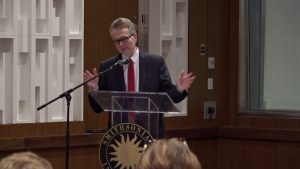Few jazz fans would argue the value of ragtime, including both its continued popularity and its huge contribution to the early development of jazz. And we know the folks to thank, the ragtimers, past and present, who’ve been “ragging” since before the turn of the last century. I recently received Tom McDermott’s latest recording for Arbors that features his interpretation of the music of the first great composer of classic ragtime, Scott Joplin.
In recent years, the folks at the Smithsonian Institution have devoted much time and effort to preserving and promoting classic ragtime and the legacy of its composers and performers. Toward that end, few have done as much as Smithsonian’s recently retired curator of American music, John Edward Hasse, who began his music career as a ragtime pianist.
John Edward Hasse been a very busy man, not only as a curator but also as a performing ragtime and jazz pianist. My wife Jean and I were fortunate to meet John when he was still a student at Indiana University in Bloomington. When we were visiting Jean’s friends in Indianapolis, they suggested we go to Nashville to hear some good jazz. I thought that would be a long trip; however, I soon discovered that Indiana also had claimed a small city with the same name. We went to a popular restaurant there called “The Ordinary.” I can attest that John was far from ordinary. When we heard him, it was obvious that he had a close kinship with ragtime and he loved to play it. I walked up to him when he finished a rag and told him that we admired his mastery of a difficult jazz genre. We talked more at his break and he told us he was at Indiana University at Bloomington finishing his doctorate.

John recently recounted to me his work at “…the Ordinary,” the usual name folks use. You can find more about it online by Googling its new name,“Out of the Ordinary, Nashville, In.” (Now that fits John to a “T.”) It’s still a very active bar-restaurant with a lot of activity. He remembered it very well. “I played there about 600 nights, nearly every Friday and Saturday for six years from 1976 to 1981.” Once he completed his doctorate, he didn’t find a job in the music world for a while but instead took a position with the Proctor and Gamble people in Cincinnati. He was part of the marketing management for Head and Shoulders shampoo brand. He states, “I was a square peg in a round hole.” So he left and “scuffled” a while as a pianist for a Cincinnati piano bar. At this point he was also presenting lecture-concerts at both colleges and high schools.
I asked John to come to Elkhart Central High School for a concert for the entire student body. They loved it and they learned a lot about John’s favorite topic: ragtime. John lectured and played the rags on piano. As well as thoroughly enjoying John’s music, Jean and I insisted that he stay with us for some of the gigs we found for him in Northern Indiana. That’s when we discovered the “real” John Hasse. He wasted no time while he was there, often running in our nearby fields or sitting at our slightly out-of-tune piano. Our conversations were almost always about “our kind of music,” so we were usually in sync about early jazz and the historical significance of ragtime. There was little doubt at that time that John was a man on the rise.
In 1984, John told me he was applying for a job as curator of American music at the Smithsonian. He called it his “dream job”: he enjoyed doing the concert-lectures, but he could now share his passion with the world. When he informed me that he had been selected, I could easily tell that he was thrilled. That thrill lasted 33 years. He went from being happily very busy to very very busy, achieving world-wide recognition for his curatorial work as well as his writing and lectures.
Perhaps his most valuable and useful work came about when he co-produced The Smithsonian Anthology of Jazz. It’s a must for any jazz DJ or serious jazz collector since it reflects the genius of nearly all the great jazz musicians. The reading material that accompanies the five CDs involves a 200 page hard-cover book, an excellent jazz history in itself. The CDs and the book are available from Smithsonian Folkways.
Since his retirement, John’s writings about jazz have appeared frequently (16 articles) in the Wall Street Journal. Currently, the Journal is about to publish his article concerning Hoagy Carmichael’s “Stardust.” John’s writing style reflects his love of his subject matter.
One of the major joys for John, during his 33 years at the museum, involves his travel to so many countries. He lectured in a number of them, sharing America’s music every chance he had. In total, he visited 58 countries and lectured in 26. John indicated to me that he thoroughly enjoyed the trips and was “grateful for the opportunity.” I want to add to that: John, we are more than grateful to you for your terrific job at the Smithsonian. We’re more than pleased that you continue to write and lecture on your favorite subject. Again, thank you, John.
Van Young has helped keep the Elkhart Jazz Festival a swinging proposition for the past three decades. He also hosts Patterns in Jazz, Sundays at noon (Central) at WGCS-FM 91.1, Goshen, IN. Listen online at www.globeradio.org.
He is currently writing a series of short memories from his interactions with jazz folk over the years. These don't count against your monthly article limit.





















